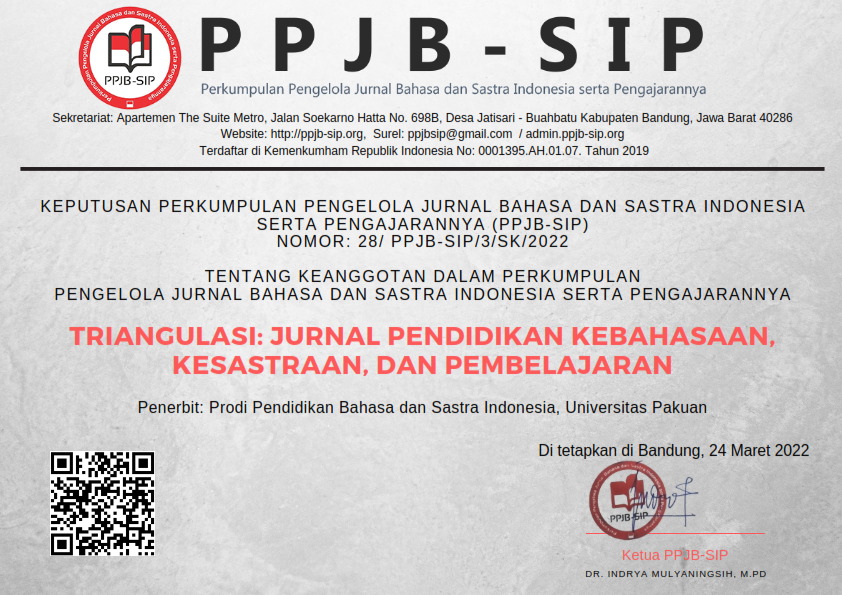Analisis Gaya Bahasa Perulangan pada Lirik Lagu dalam Album Monokrom Karya Tulus dan Implikasinya Terhadap Pembelajaran Bahasa Indonesia di SMA
Abstract
Keywords
References
Emzir. 2015. Metodologi Penelitian Pendidikan Kuantitatif dan Kualitatif. Edisi yang Diperbarui. Cetakan 9. Jakarta: PT Raja Grafindo Persada.
Finoza, Lamuddin. 2008. Komposisi Bahasa Indonesia. Cetakan 151. Jakarta: Diksi.
http://hariannetral.com/2015/08/pengertian-puisi-dan-unsur-unsur-puisi-lengkap.html# (Diakses pada 21 November 2018)
https://media.neliti.com/media/publications/55527-ID-pembelajaran-sastra-sebagai-salah-satu-w.pdf (Diakses pada 21 November 2018)
http://www.sekolahdasar.net/2012/04/tujuan-dan-fungsi-pembelajaran-bahasa.html. (Diakses pada tanggal 6 Juli 2018)
Keraf, Gorys. 2009. Diksi dan Gaya Bahasa. Edisi yang Diperbarui. Cetakan 21. Jakarta: PT Gramedia Pustaka Utama.
Kosasih, E. 2008. Apresiasi Sastra Indonesia. Jakarta: PT Perca.
Moleong, Lexy J. 2017. Metodologi Penelitian Kualitatif. Cetakan 36. Bandung: PT Remaja Rosdakarya.
Redaksi Immortal. 2012. Kamus Pintar Pantun Puisi dan Majas. Cetakan 3. Yogyakarta: Immortal Publisher.
Salad, Hamdy. 2015. Panduan Wacana dan Apresiasi Musikalisasi Puisi. Yogyakarta: Pustaka Belajar.
Sj Prier Edmund, Karl. 2008. Sejarah Musik Jilid 1. Cetakan 7. Yogyakarta: Percetakan Rejeki.
Sujarweni, Wiratna. 2014. Metodologi Penelitian. Yogyakarta: Pustakabarupress
Tarigan, Guntur. 2009. Pengajaran Gaya Bahasa. Edisi Revisi. Bandung: Angkasa
DOI: 10.55215/triangulasi.v1i1.3215
 Abstract views : 1855
Abstract views : 1855
Refbacks
- There are currently no refbacks.
Copyright (c) 2021 Triangulasi: Jurnal Pendidikan Kebahasaan, Kesastraan, dan Pembelajaran

This work is licensed under a Creative Commons Attribution-NonCommercial-ShareAlike 4.0 International License.




